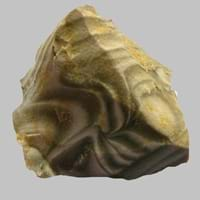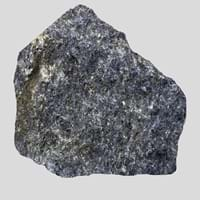Definition
Flint is a hard type of sedimentary rock that produces a small piece of burning material when hit by steel
Blueschist is a metamorphic rock which is generally blue in color and is formed under conditions of high pressure and low temperature
Discoverer
Unknown
Edgar Bailey
Etymology
From Old English flint - a type of rock mainly known for high hardness and for giving off sparks when struck
From French schiste, Greek skhistos i.e. split
Class
Sedimentary Rocks
Metamorphic Rocks
Sub-Class
Durable Rock, Hard Rock
Durable Rock, Medium Hardness Rock
Group
Not Applicable
Not Applicable
Other Categories
Fine Grained Rock, Opaque Rock
Fine Grained Rock, Medium Grained Rock, Opaque Rock
Texture
Banded, Rough
Foliated
Color
Black, Brown, Green, Grey, Red, White
Blue, Bluish - Grey, Purple, Shades of Blue
Durability
Durable
Durable
Appearance
Glassy or Pearly
Dull and Banded
Interior Uses
Decorative Aggregates, Homes, Interior Decoration
Floor Tiles, Flooring, Homes, Hotels, Kitchens
Exterior Uses
As Building Stone, As Facing Stone, Garden Decoration, Office Buildings, Paving Stone
Garden Decoration, Office Buildings
Other Architectural Uses
Curbing
Not Yet Used
Construction Industry
Arrowheads, Cutting Tool, Spear Points
As Dimension Stone, Cobblestones, Rail Track Ballast, Roadstone
Medical Industry
Not Yet Used
Not Yet Used
Antiquity Uses
Artifacts
Artifacts, Monuments, Sculpture
Commercial Uses
Creating Artwork, Gemstone, In fire-starting tools, Manufacture of tools, Metallurgical Flux, Jewelry, To ignite fire, Used in flintlock firearms
Cemetery Markers, Commemorative Tablets, Creating Artwork, Curling, Tombstones
Types
Not Available
Not Available
Features
Clasts are smooth to touch, Easily splits into thin plates, Has High structural resistance against erosion and climate
Has High structural resistance against erosion and climate, Very fine grained rock
Archaeological Significance
Monuments
Not Yet Used
Used
Famous Monuments
Not Applicable
Data Not Available
Sculpture
Not Yet Used
Used
Famous Sculptures
Not Applicable
Data Not Available
Pictographs
Not Used
Used
Petroglyphs
Not Used
Used
Figurines
Not Yet Used
Used
Formation
Flint is formed by the decomposition and compaction of various organisms such as sponges and diatoms under the water.
Blueschist forms due to the metamorphism of basalt and other rocks with similar composition at high pressures and low temperatures and approximately corresponding to a depth of 15 to 30 kilometers and 200 to 500 °C.
Mineral Content
Silicon
Albite, Chlorite, Epidote, Garnet, Glaucophane, Lawsonite, Muscovite or Illite, Quartz
Compound Content
Silicon Dioxide
Aluminium Oxide, CaO, Iron(III) Oxide, FeO, Potassium Oxide, MgO, MnO, Sodium Oxide, Phosphorus Pentoxide, Silicon Dioxide, Titanium Dioxide
Types of Metamorphism
Not Applicable
Not Applicable
Types of Weathering
Not Applicable
Mechanical Weathering
Types of Erosion
Chemical Erosion, Coastal Erosion, Water Erosion
Chemical Erosion, Coastal Erosion, Water Erosion, Wind Erosion
Grain Size
Very fine-grained
Fine to Medium Grained
Fracture
Conchoidal
Conchoidal
Streak
White
White to Grey
Porosity
Highly Porous
Highly Porous
Compressive Strength
Not Available
Cleavage
Non-Existent
Slaty
Specific Gravity
2.5-2.8
3-3.2
Transparency
Translucent to Opaque
Opaque
Density
2.7-2.71 g/cm3
2.8-2.9 g/cm3
Specific Heat Capacity
Not Available
Resistance
Heat Resistant, Impact Resistant, Pressure Resistant, Wear Resistant
Impact Resistant, Pressure Resistant
Deposits in Eastern Continents
Asia
Azerbaijan, China, Russia
Japan, Turkey
Africa
Not Yet Found
Egypt, Ethiopia, South Africa
Europe
Austria, Belgium, Cyprus, Denmark, France, Germany, Italy, Malta, Netherlands, Poland, Portugal, Romania, Spain, Sweden, Switzerland, Turkey, Ukraine, United Kingdom
France, Greece, Iceland
Others
Not Yet Found
Not Yet Found
Deposits in Western Continents
South America
Bolivia
Not Yet Found
Deposits in Oceania Continent
Australia
New Zealand, South Australia
New Zealand
All about Flint and Blueschist Properties
Know all about Flint and Blueschist properties here. All properties of rocks are important as they define the type of rock and its application. Flint belongs to Sedimentary Rocks while Blueschist belongs to Metamorphic Rocks.Texture of Flint is Banded, Rough whereas that of Blueschist is Foliated. Flint appears Glassy or Pearly and Blueschist appears Dull and Banded. The luster of Flint is vitreous while that of Blueschist is dull. Flint is available in black, brown, green, grey, red, white colors whereas Blueschist is available in blue, bluish - grey, purple, shades of blue colors. The commercial uses of Flint are creating artwork, gemstone, in fire-starting tools, manufacture of tools, metallurgical flux, jewelry, to ignite fire, used in flintlock firearms and that of Blueschist are cemetery markers, commemorative tablets, creating artwork, curling, tombstones.










